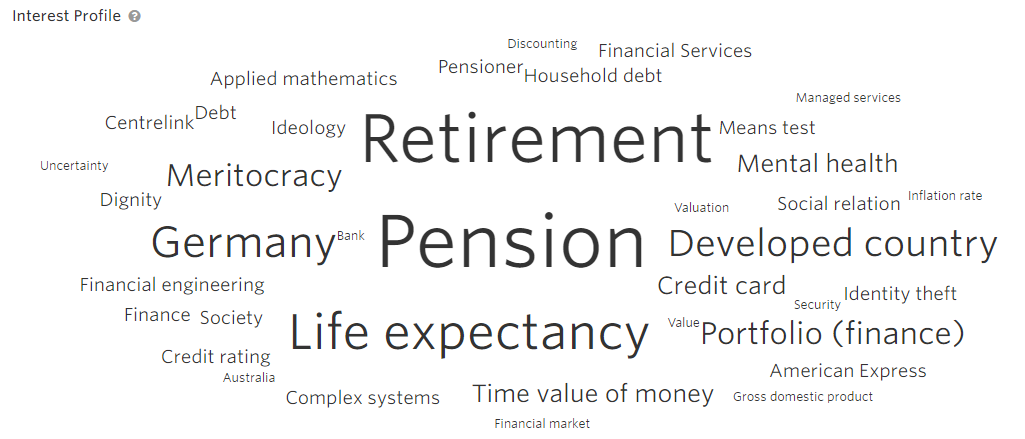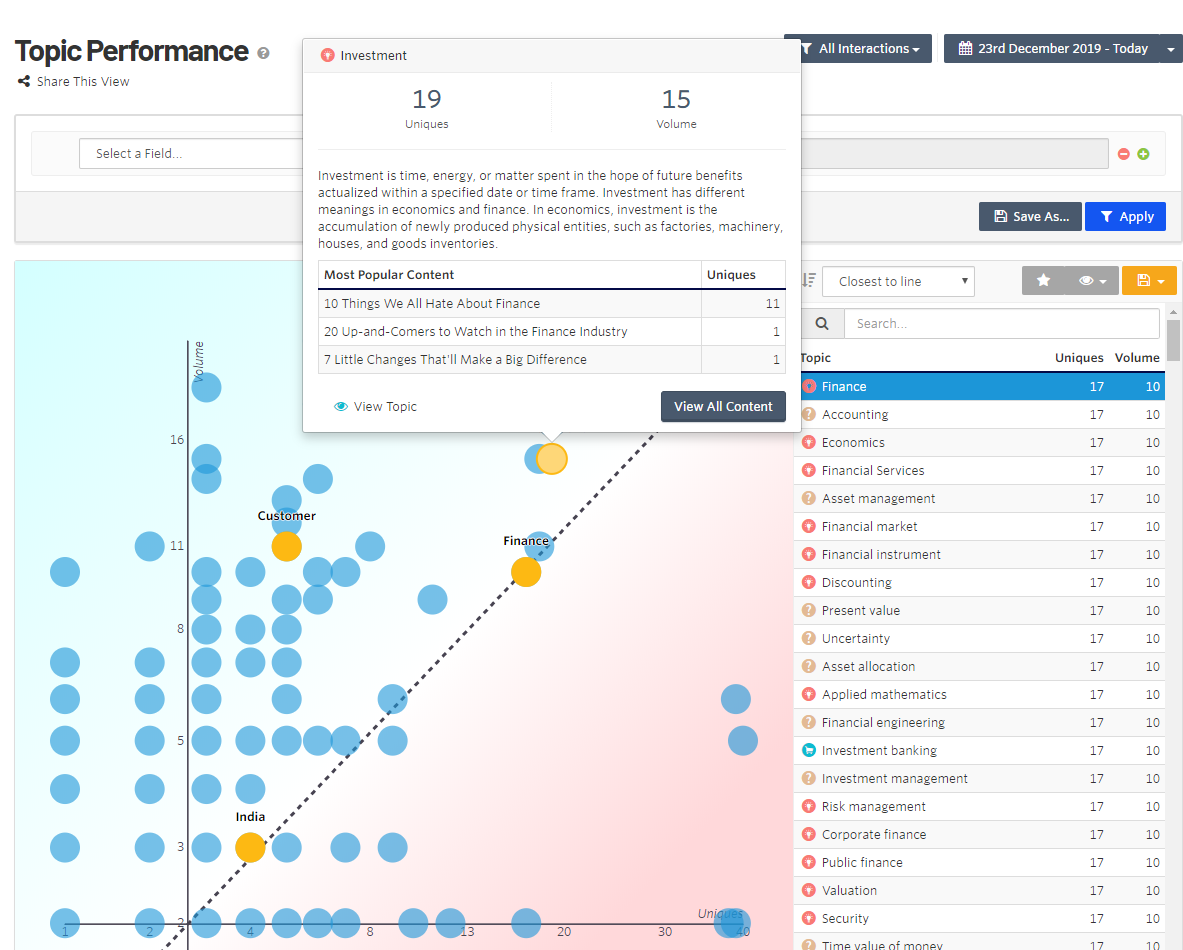 Content Recommendations
Content Recommendations
Content Recommendations anonymously tracks visitor Someone who visits a website using a web browser. In most cases, a visitor can use public functions and services but cannot create content and has limited access to community content. In an SEO context, visitor means the number of visits to a URL through channels (external referrers), direct arrivals, and internal links. (See also visitor groups.) activity on a website to build a profiles for each visitor. Analysis of a unique profile lets you deliver the most relevant content to each visitor.
For example, based on the visitor's activity on the website, the topic cloud in the following image shows a visitor's interest in retirement, which you can use to recommend articles, blog posts, or other content related to retirement planning.

Content Recommendations uses Natural Language Processing (NLP Natural language processing. A subfield of linguistics, computer science, information engineering, and artificial intelligence concerned with the interactions between computers and human (natural) languages, in particular how to program computers to process and analyze large amounts of natural language data. - Source: Wikipedia) to match content that shares the greatest degree of similarity of an individual user’s interest profile A data representation of an individual's interests based on site activity, derived from the near real-time modeling of topics contained within the URLs that the individual visited. in real-time. As the user’s interest profile changes with more content consumption, the corresponding recommendations change appropriately.
Content Recommendations has many evaluation tools to help you improve your content. For example, the topic performance chart shows how much interest there is in a topic. See Topic performance.

You can use Content Recommendations with the rest of Optimizely in some following example ways:
- A/B Testing. Use built-in A/B testing with your recommendation blocks to determine where on the page a block gets the best results. You can monitor a block’s performance over the life of your A/B test to determine which placement or design gets the best click-thru results.
- Visitor Groups. Trying to decide which persona should see which content? Create a visitor group on a particular page, and use two different blocks and deliveries Deliveries include retargeting, blocks on a web page, and personalized email that contains relevant content that is based on previous interactions and interests. to deliver two different experiences. You could deliver content-group-A to new users to the site, which selects from a different content flow and section; then content-group-B to returning visitors, depending on your tactics.
Terminology
The following terms are associated with Content Recommendations.
- Content dashboard. Lets you analyze the number of content items, unique topics, average number of topics per content item, natural language processing, and so on. To use dashboard filters, see Filtering.The Content Dashboard also lets you analyze the following:
- Sources. Shows the URL Stands for "Uniform Resource Locator". Also known as a web address such as http://world.optimizely.com.s where content items are viewed and interacted with.
- Contents. Shows each content item processed by Content Recommendations.
- Sections. Shows groups of content based on flow rules.
- Flows. Shows rules for sections. You also can create rules.
- Properties. Shows the Internet and email areas that Content Recommendations tracks.
- Insight Dashboard. Lets you track and analyze visitor interactions with your site, and the following:
- Topic Performance. Shows a graph of Volume versus Uniques and plots topics on the graph.
- Content Utilization. Shows content that performs well or not so well.
- Profiles. Shows details about a visitor profile.
- Goals. Shows conversions.
- Engage dashboard. Lets you analyze recommendations and the following.
- Deliveries. Set up deliveries to drive personalized marketing to key customers.
The menu item Deliveries requires extended user rights. Contact your Content Recommendations administrator.
- Deliveries. Set up deliveries to drive personalized marketing to key customers.
- Settings. Lets you configure the Content Dashboard.
- Configuration. Set up master filters or IP address filters.
- Shared Views. Shows views shared by Content Dashboard users.
- Topic Selections. Displays private or shared selections.
- Source. The origin of content that is ingested The process of gathering topics for analysis. For example, if a new URL is added to your website where Content Recommendations is implemented, that content is ingested into the system. If content changes after it was ingested, you can reprocess the content. into the system.
- Content item. A web page that has an identifier associated with it.
A content item can contain many topics Content Recommendations: An indexed subject, such as finance, insurance, hamburgers, rocks, or a brand name.. For example, if you use a filter to look for insurance, Content Recommendations finds insurance on pages and returns the URLs where it is found.
Content Recommendations analyzes and audits content to show the following for each content item:
- source
- URL
- import and publish dates
- text content
- metadata associated with the content
- images linked to the content
- Topic. An indexed subject, such as finance, insurance, hamburgers, rocks, or brand name.
A topic is prioritized (weighted) based on the following criteria:
- frequency in a content article (higher weight value)
- frequency across all content articles (lower weight value).
If a topic appears many times in an article, but also appears in many other documents, the weight is the average of the higher and lower weights.
- position of a topic in a content article
- time (how recent) since interacting with the topic. A topic becomes less weighted if a user has not interacted with content articles that include the given topic for a longer period of time.
- Section. Groups of content based on content/asset type, business category, industry, language or any grouping criteria of your choice.
- Ingestion. The process of gathering topics for analysis. For example, if a new URL Stands for "Uniform Resource Locator". Also known as a web address such as http://world.optimizely.com. is added to your website where Content Recommendations is implemented, that content is ingested into the system. If content changes after it was ingested, you can reprocess the content.
- Flow. Rules for sections Content recommendations: Groups of content based on flow rules. For example, a Europe section may include blog posts about London, Amsterdam, or Paris; while an Asia section may include blog posts about Shanghai, Hong Kong, or Tokyo. based on titles, URLs, or metadata, to group content.
- Goal. A set of behaviors that you want someone to perform, such as filling out a form, requests for demos, downloading a resource, or viewing three pages on the Financial site. This helps to determine how interested a visitor is in the content. The idea is that people who view three pages on a financial site may be very interested in, say, Retirement planning.
- Session. The time span of activity for a visitor.
- Unique. A specific visitor to your website for a session.
If a visitor visits your website after a previous session expired, a new session occurs and adds to the unique visitor count.
- Volume. The number of times a unique visitor Marketing Automation: the number of unique IP addresses that visited this page/URL during a specified period. views pages on your website during a session.